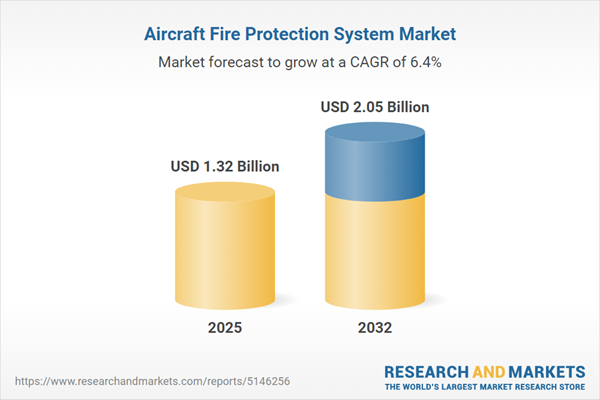Speak directly to the analyst to clarify any post sales queries you may have.
The aircraft fire protection system market is becoming a top priority for aviation executives seeking operational reliability, compliance, and risk mitigation throughout the global aviation landscape. Effective fire protection strategies are instrumental in safeguarding both passenger safety and asset integrity.
Market Snapshot: Trends and Growth in the Aircraft Fire Protection System Market
The global aircraft fire protection system market is anticipated to grow from USD 1.24 billion in 2024 to USD 1.32 billion in 2025, representing a compound annual growth rate (CAGR) of 6.43%. The market is forecast to reach USD 2.05 billion by 2032. Demand is driven by ongoing investments from commercial airlines, defense agencies, and specialized operators who require cutting-edge systems to support evolving fleet safety demands. Modernization efforts and shifts in regulations are prompting decision-makers to reevaluate their risk strategies and prioritize advanced real-time detection, integrated fire suppression platforms, and improved operational standards. This focus not only sustains operational stability but also enhances resilience and sector continuity in diverse market environments.
Scope & Segmentation: Aircraft Fire Protection System Market
This report delivers in-depth analysis targeted at senior decision-makers requiring actionable insights into fire safety innovations, supplier landscapes, and regional growth drivers throughout the aviation sector. Segmentation is structured to aid in pinpointing investment areas and understanding the unique requirements of global markets.
- Core Components: Includes control panels, detection sensors, extinguishing devices, suppression agents, nozzles, and dispersal modules, offering fast protection solutions adaptable to both legacy and modern aircraft.
- Detection Technologies: Features continuous loop systems, infrared and ultraviolet sensors, optical smoke detectors, ionization-based devices, and thermal switches, designed to align with global safety mandates and boost operational capabilities.
- Aircraft Types: Encompasses business jets, commercial airliners, helicopters, military aircraft, and unmanned aerial systems, each facing distinct missions and compliance landscapes.
- Installation Options: Covers both new installations and retrofits, supporting enhanced fleet safety and the integration of new solutions onto existing assets.
- Key Industry Participants: Highlights roles of distributors, MRO providers, OEMs, and service centers, all contributing to consistent fire protection adoption and ongoing maintenance excellence.
- Regional Markets: Analyzes the Americas, Europe, Middle East, Africa, and Asia-Pacific, including key regional growth areas such as China, Japan, India, Australia, South Korea, and Southeast Asia.
- Leading Suppliers: Reviews sector players—Raytheon Technologies Corporation, Honeywell International Inc., Meggitt PLC, Eaton Corporation plc, Parker-Hannifin Corporation, Safran S.A., Amphenol Corporation, AMETEK, Inc., Siemens AG, and Curtiss-Wright Corporation—for their roles in innovation, compliance, and overall sector leadership.
Key Takeaways: Strategic Insights for Decision-Makers
- Heightened regulatory scrutiny requires aviation organizations to maintain adaptive compliance frameworks and update emergency protocols in response to shifting risk landscapes.
- Digital fire protection systems are enabling proactive, data-driven maintenance strategies, allowing repair teams to transition from reactive actions to predictive planning for improved efficiency and uptime.
- Integration of advanced, lightweight materials into fire suppression solutions is helping to balance durability requirements with the need for sustainability and operational performance improvements.
- Market movement toward modular and open system architectures allows for greater supply chain flexibility, helping to simplify equipment certification and reinforce overall fleet resilience.
- Aftermarket solutions play a pivotal role in supporting ongoing operational continuity and strengthening customer engagement within maintenance and support cycles.
- Comprehensive compliance monitoring supports more effective procurement strategies and helps organizations target investments that unlock operational advantages amid evolving standards.
Tariff Impact on Market Dynamics
Recent changes in U.S. tariffs are shaping sourcing and manufacturing decisions for aircraft fire protection components. This shift is broadening the diversity of suppliers, prompting greater regional production, and encouraging the use of free trade zones. Through these strategies, operators and suppliers can reinforce global supply chain stability and minimize disruption during regulatory adjustments.
Methodology & Data Sources
The report leverages interviews with senior decision-makers, technical webinars, regulatory bulletins, patent analyses, and comprehensive technical documentation. Supplemental perspectives from industry stakeholders and active tracking of international trade developments provide context for both technology and regulatory trends.
Why This Report Matters
- Provides executives with data-backed guidance to align technology integration, compliance, and risk strategies within their organizations.
- Facilitates strategic procurement and capital allocation in response to changing safety standards and global compliance obligations.
- Strengthens engagement with reliable suppliers, setting standards for quality and dependability in the operation of essential aircraft fire protection systems.
Conclusion
Aviation sector executives can use these insights to optimize fire protection initiatives, advance compliance priorities, and reinforce operational reliability across both current and future fleet assets.
Additional Product Information:
- Purchase of this report includes 1 year online access with quarterly updates.
- This report can be updated on request. Please contact our Customer Experience team using the Ask a Question widget on our website.
Table of Contents
3. Executive Summary
4. Market Overview
7. Cumulative Impact of Artificial Intelligence 2025
Companies Mentioned
The companies profiled in this Aircraft Fire Protection System market report include:- Raytheon Technologies Corporation
- Honeywell International Inc.
- Meggitt PLC
- Eaton Corporation plc
- Parker-Hannifin Corporation
- Safran S.A.
- Amphenol Corporation
- AMETEK, Inc.
- Siemens AG
- Curtiss-Wright Corporation
Table Information
| Report Attribute | Details |
|---|---|
| No. of Pages | 181 |
| Published | October 2025 |
| Forecast Period | 2025 - 2032 |
| Estimated Market Value ( USD | $ 1.32 Billion |
| Forecasted Market Value ( USD | $ 2.05 Billion |
| Compound Annual Growth Rate | 6.4% |
| Regions Covered | Global |
| No. of Companies Mentioned | 11 |









